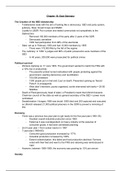Summary
Summary Chapter 10- East Germany, Democracy and Dictatorships in Germany - revision notes
A table on the German economy throughout - all you need to answer any essay question on the economy Condensed revision/Sumarry notes on Chapter 1,2,3,4,6,7,9,10 (chapter 5 and 8 missing- those focused on economy so made up for that with the table) Perfect set of summary notes for revision and ma...
[Show more]





